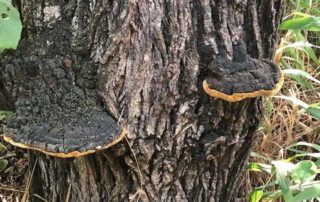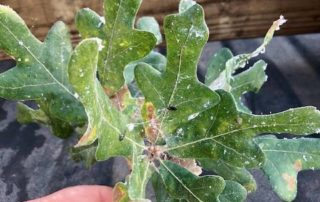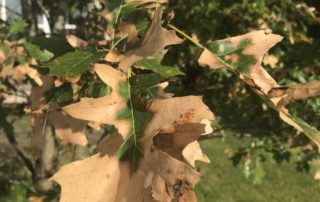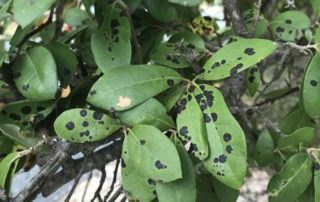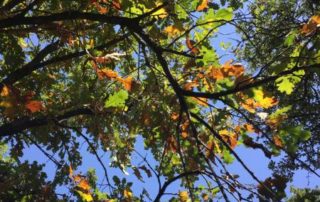Our Tree Care Services Austin, TX
We at Good Guys Tree Service truly care about the health of your trees. We like to consider ourselves as the tree doctors of Austin! With over 20 years experience in this industry, as well as certified arborists on staff, you can be assured to get the highest quality tree care services.
Services We Provide As Tree Doctors Who Care
- Chlorosis & Other Mineral Deficiencies
- Fungal Infections
- Conks, Cankers, Brackets & Armillaria growths
- Bacterial Infections
- Wound Care
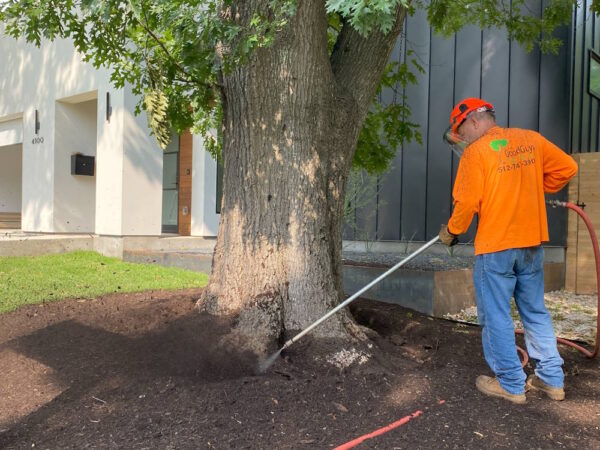
Chlorosis & Other Mineral Deficiencies Needed For Proper Tree Care
Like all living things, trees need a number of minerals in order to grow and thrive properly. Iron and Manganese deficiencies are near ubiquitous in trees for Central Texas. Fortunately, Good Guys Tree Service is on the front lines in the treatment of chlorotic and nutrient deficient trees!
What to look for: If your tree’s leaves look lighter green then normal or even yellow or bleached in appearance, this is a sure sign the tree is anemic and suffering from a condition called chlorosis. If your leaves are blotchy or underdeveloped, this can be caused by a deficiency of other micronutrients such Manganese or Zinc.
Tree care treatment options: The quickest and most effective treatment is a direct injection into the tree. A liquid blend specially formulated for maximum metabolization and absorption within the tree’s vascular system can show recovery results in as little as 4 weeks! Other treatments address the soil and look to boost the available nutrient levels and modify the PH to assist the tree’s own root system in proper mineral absorption. See our “Amendments & Fertilizers” section for more.
Good Guys Tree Service provides certified arborist consultations, full treatment programs and complete tree maintenance services. Contact us today to schedule an appointment and ask about our current promotions!
Fungal Infections That Truly Need a Tree Doctor
Funguses are a huge problem for trees here in Austin, TX. There are far too many types of fungal infections to list here, so it is better to focus on symptoms that best signal that there may be a fungus issue in your tree. Leaves that appear spotted, streaked, or moldy almost certainly have a fungal infection going on. Twigs that seem dead on the tips or cases where the leaves seem warped or underdeveloped may also be symptoms of a fungal attack.
Diagnosis & Treatment: Diagnosing the exact species of Fungus can be difficult even for train arborists sometimes. A sample must be sent to a lab in order to be sure, and it can take several weeks to over a month to get results back. Fortunately, this is unnecessary in most cases. If a fungus of any kind is determined to be the culprit, the same systemic fungicides are used regardless. Tree injections or foliar sprays are used to control the spread of the disease. Often, select pruning and leaf litter clean-up are employed to reduce the chance of reinfection.
Bacterial Infections
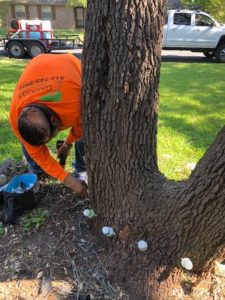 Bacterial infection in trees manifests for the most part as leaf blights, root rots, and festering wound sites. Most common in fruiting trees, leaves may appear scorched, shriveled or burnt at the tips. Injuries to the tree caused by animals, insects or misfortune will ooze black slim when infection is present. Root rot is harder to detect sometimes. A tree may appear sick or wilted with no apparent cause. Partially digging up the root zone of the tree is often the only way to verify a root rot problem is the cause of an otherwise unexplained decline in a tree’s health.
Bacterial infection in trees manifests for the most part as leaf blights, root rots, and festering wound sites. Most common in fruiting trees, leaves may appear scorched, shriveled or burnt at the tips. Injuries to the tree caused by animals, insects or misfortune will ooze black slim when infection is present. Root rot is harder to detect sometimes. A tree may appear sick or wilted with no apparent cause. Partially digging up the root zone of the tree is often the only way to verify a root rot problem is the cause of an otherwise unexplained decline in a tree’s health.
Care & Treatment: In many of the cases where bacteria may be attacking your tree, it is primarily an environmental issue that first needs to be addressed. If insects are causing wounds, insecticide treatments should be deployed to control them. Root rot is usually caused by poor drainage or a high amount of rotting materials adjacent to or beneath your tree. Efforts must be made to rectify such problems before any chemical or medicinal treatment can be expected to be effective.
Bacterial infection of the canopy is also likely aided by factors such as excessive shade, sprinkler systems that dampen the leaves far to frequently, or canopy crowding. Trees planted too closely together can stifle air flow and give bacteria the moisture levels it prefers, enabling rapid spread. Once these potential issues have been addressed, antibiotic and/or immune system elicitors can help the recovery process. In some cases, infected leaves must all be pruned, and all affected debris disposed of in order to control for reinfection. Consult with your arborist to confirm the most advisable treatment plan, every case is unique and treatment strategies can differ from species to species of tree.
Conks, Cankers, Brackets & Armillaria growths
These are all technically Fungi as well but are usually not the cause of decline in a tree. These are normally seen growing from parts of a tree that has already died for some other reason. Such growths are opportunistic in nature and are much like what vultures are to roadkill. If seen growing on a branch, simply removing the branch with a proper cut should resolve the issue. If the growths are instead on the trunk of the tree, this is a major problem.
Treatment Options: There is no treatment to control or eliminate this problem if it appears on the main trunk of the tree. The dead wood inside the trunk that is feeding the fungi will remain dead and any fungicide applied would only temporarily abate growth. The general consensus among arborists is that the presence of fungal pads or brackets on the trunk are a signal that a tree is in an irreversible decline.
Does this mean the tree should be removed immediately?
This depends on the location of the fungal growths and the progression of the dieback in the tree. Fungi protruding from an upper limb can be pruned out as previously suggested. But if seen at the base of the tree or on a side of the main trunk, the weakened tree will become increasingly unstable and given enough structural damage, a sudden fall becomes imminent. Have a certified arborist assess the tree to ascertain its condition and how at risk your sick tree may be.
Wound Care
Whether caused by nature or human activity, broken or cracked limbs are part of a tree’s life. Bark that has been chafed off or smashed, holes chewed through by insects or squirrels, all such wounds are found on almost any tree. The size and extent of the damage is key to assessing the threat level to a tree’s overall health. The smaller the better, and any wound that exceeds 20% of a given region of the tree is considered severe damage.
Treatment: Our first inclination as humans is to bandage or seal a wound site. With trees this is not advisable in most cases. With the exception of Oak trees in areas with a high-risk of oak wilt, most species of tree respond better by having the wound left open to the air. Bandaging or tarring wound sites may do more harm than good. By trapping moisture and creating cover from the elements, such “remedies” can retard natural healing and attract insects and bacteria to the wound site. Trees with broken branches are almost always better off having the limb pruned with a proper cut, allowing the tree to heal rapidly.
Trees are remarkable in their ability to repair themselves. From car impacts to lightening strikes, some of the oldest trees around show scars from past misfortunes. Remarkably these trees have often recovered. The years immediately following a wound tend to predict the direction and outcome for the tree. If rapid healing and regrowth are seen, it is likely the tree will go on to outlive you and I with any luck. If instead the wound deepens and bark is seen falling off above or below the wound, this will likely continue until the tree is so decayed and damaged that recovery becomes impossible. To help tip the scale in the right direction, there are proven products available that boost healing and promote regrowth! Though not always necessary, such treatments have made the difference for badly damaged trees.
Insect Infestation
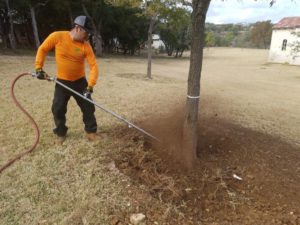 On the leaves: Insects live in every tree and there can hardly be found a tree that doesn’t have some minor nibbling on the occasional leaf. The presence of these insects in measured numbers is hardly a threat to your tree and may even attract natural predators of such bugs, allowing for a natural control of the population. Infestation of your tree is considered a health factor when approximately 10%-15% of the canopy has been damaged or lost due to insect activity.
On the leaves: Insects live in every tree and there can hardly be found a tree that doesn’t have some minor nibbling on the occasional leaf. The presence of these insects in measured numbers is hardly a threat to your tree and may even attract natural predators of such bugs, allowing for a natural control of the population. Infestation of your tree is considered a health factor when approximately 10%-15% of the canopy has been damaged or lost due to insect activity.
In the wood: Sawdust shavings on the ground at the base of the tree is a bad sign. Excessive woodpecker activity is also not good as they are only attracted to the presence of beetle larva (grubs) under the bark. Sudden dieback of large sections of the tree, or unexplained loss of whole limbs that seemed healthy only months ago, are also a tell that insects may be chewing galleries within your tree.
Of the roots: Poor growth, canopy loss or signs of dehydration despite regular watering can be the first clues that your root zones may have a pest damaging them.
Treatment & Control: Fortunately, insect problems are one of the easier issues to address and eliminate. A wide variety of insecticide products are available and if targeted to the species of insect involved, the control of and recovery from most infestations can begin within minutes of application. Soil drenches or injections are usually the most effective. Insecticide sprays are only rarely advisable. Canopy sprays as a treatment method are limited in duration of effectiveness, being affected by rainfall. Leaf scales and mites are hardest to control and in severe cases a combination of foliar sprays and injections are used to destroy both the feeding adults and the unhatched eggs throughout the canopy. Experienced arborists can usually identify a insect problem at a glance, and often a diagnosis can be obtained by simply showing an arborist a close picture of your tree.
Soil Compaction
The soil under and surrounding your tree is home to at least half of the tree! Considering that fact, soils that have compacted past a certain point present a host of problems for any tree. Water will fail to adequately soak down to the roots. Root growth will be hindered, and vital nutrients will remain inaccessible, locked in soil too hard for roots to infiltrate. Slowly, a tree can be suffocated. Smothered too death by the heavy pillow of compacted dirt. Why does this happen? It is usually an issue with trees that find themselves in high traffic areas. Perhaps a foot path wraps around the tree in a park setting. Trees in playgrounds or near popular picnic sites are often harmed. Trees in lawns where ride-on mowing equipment is driven once or twice a week over the grass under the tree. And last, but not least, nearby construction projects. Any one of these scenarios can lead to a compaction issue. Quite often it is almost all of these things going on around the same tree! The more activity around the tree of anything that weighs more than a small dog, the higher the risk.
Solving the problem: A two-pronged attack is required to reverse the damage.
First, a procedure called vertical mulching is used to perforate the compacted soil and allow water to again reach the affected root zones. Vertical mulching is done by using an 1-1/2” wide auger bit to drill holes in the ground 8”-12” down. The holes are filled with a mix of pea gravel and peat moss to keep a percolation channel open, preventing the hole from simply refilling with dirt. By drilling a hole every 2 feet or so in a grid pattern beneath the tree, immediate access in gained for rain or irrigation water to rehydrate the soils surrounding the tree.
Second, it is crucial that the area under the tree be restricted from further soil compaction. Creating a lightly mulched and bordered landscape bed is usually sufficient. In open parks or playground areas, actual fencing may be needed to protect the root zone beneath the tree.
One last service is sometimes used and that is deep root fertilization. By adding a supportive fertilizer to the soil, it can have the dual effect of both stimulating growth and breaking up hardened soil simply from the mechanics of the pressurized formula being injected 6” beneath the ground surface.



